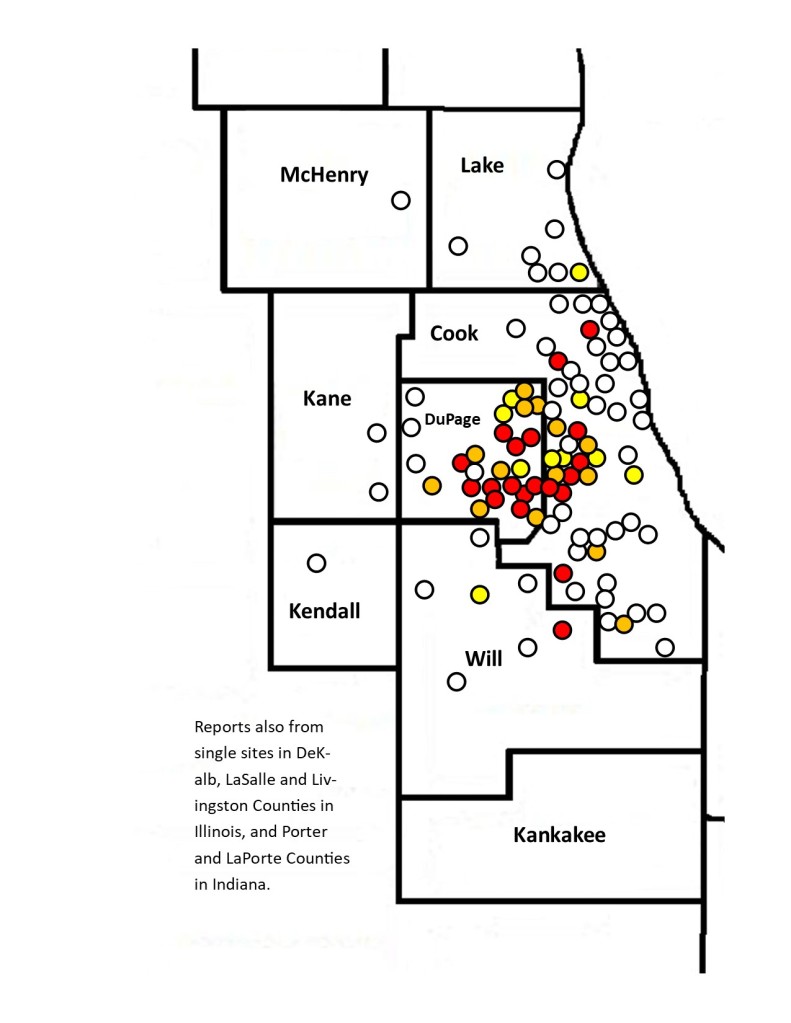by Carl Strang
Later this month, periodical cicada Brood XIII will begin to emerge in northern Illinois and parts of adjacent states. From mid-May to mid-July my research priority will be to gather observations that will help me fill out the story of these amazing insects in the region.

During the previous emergence in 2007, I focused on DuPage County. I found that the cicadas were concentrated in the eastern part of the county, where urban forests, created mainly along commuter railways, allowed cicada populations to expand beyond the historically forested areas. Cicadas generally were absent from western DuPage, where the forests had been cut down for agriculture.

[Map of DuPage County, summarizing past periodical cicada observations. Pink shaded areas mark where the major emergence occurred in 2007. Brightly colored dots mark places where cicadas emerged in 2020. Black dots show where wave choruses appeared in 2023.]
One goal this year will be to repeat the DuPage survey, to see how much (if at all) the major emergence areas have expanded a generation later. I also will be interested to see if additional new areas might have been established by dispersing gravid females.
A remarkable side story has been the repeated appearance of numbers of periodical cicadas four years ahead of the main emergences. This first was reported in 1969, and in 2000 I found that the cicadas reproduced in sufficient numbers that they have established a separate, independently reproducing parallel population in part of the Brood XIII area.

[Distribution of periodical cicada locations in 2020. In this and the previous map, red dots show areas of the highest population densities, where the cicadas reproduced in sufficient numbers to carry into another generation.]
There also were a few tiny areas, each less than a city block in size, where many cicadas emerged last year (indicated by black dots on the topmost map). These did not, however, successfully reproduce. I will return to the high emergence areas this year, to see if they also have strong numbers four years later. This is to test the possibility that the early emergences are the result of overcrowding underground. Such a scenario was predicted by researchers decades ago, and if so, a strong emergence is expected in those same areas this year. A lack of cicadas in those areas would support an alternative hypothesis, that climate change may be responsible.
I also want to get a sense of the extent of Brood XIII in southeastern Wisconsin, northwestern Indiana, and southwestern Michigan. Historical records show that the adjacent Brood X occurred in every Indiana county, but that there was an extension of Brood XIII along the northern fringes of the northwesternmost counties. In 2021 I found three surviving Brood X populations in northwest Indiana, all south of the Valparaiso Moraine.

[Locations of Brood X populations in 2021. The blue line marks the crest of the Valparaiso Moraine.]
I suspect that the Grand Kankakee Marsh, which was bounded on its north edge by the Valparaiso Moraine, historically was a barricade dividing Brood X from Brood XIII, and I hope to get some confirming observations this year.
Finally, I need to check two locations where a third periodical cicada species reportedly was found in Cook County in the past. These were based on museum specimens, however, and the physical characteristics of these species are variable enough that they need to be documented behaviorally with song recordings.